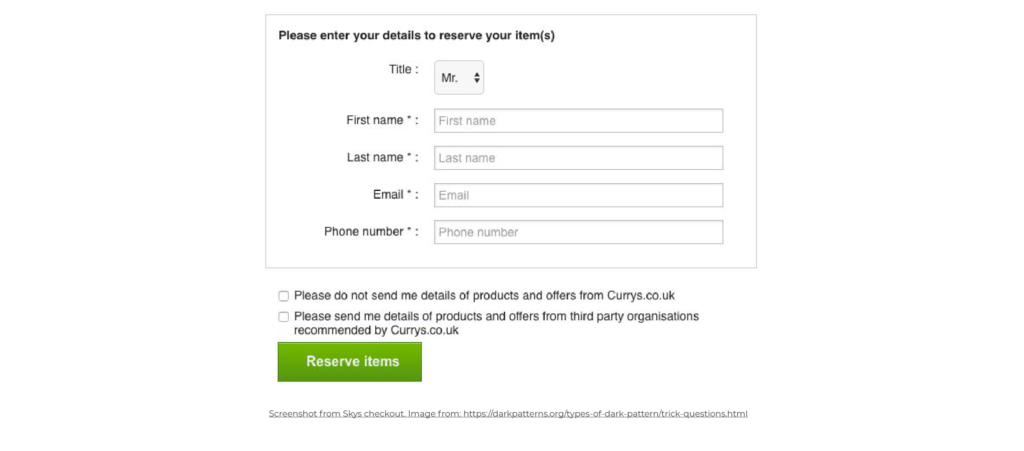Dark Patterns: the unethical UX implementations
UX design is an area of design that advocates for its users and aims to create the most accessible, user-friendly solutions possible. As part of this, many decisions have to be made while balancing both user needs and business goals and requirements. Due to this, many decisions can be made that can provide quick business wins but poor user experiences. Some of these decisions are known as dark patterns and are considered to be unethical design implementations. Dark patterns are defined as deceptive interactions which are designed to mislead or trick users into doing something that they don’t want to do. So what are some common dark patterns? Below I list 5 common dark patterns seen on eCommerce websites.
Trick Questions
Trick Questions is the act of tricking users into giving you an answer that they didn’t intend to give. This is commonly seen on form checkboxes. In these instances, the questions are phrased so that on a quick glance they appear to ask one thing, however, when examined carefully they in fact mean the opposite. These are often used to trick users into opting into mailing lists. The language used confuses the user into thinking that by checking the box they will be opted out, but it actually opts them in.

Bait & Switch
Bait and Switch is the practice of tricking users into making a decision they had no intention of doing. This dark pattern is commonly seen in conjunction with the last one (Trick Questions). It is common for companies to give users a false understanding of what an action, such as clicking on a checkbox, does. Going back to the previous example of opting into a mailing list. Companies will often use a T&C (terms and conditions) checkbox to trick users into thinking that clicking the box will opt them in thus agreeing to the T&Cs. However, this will then be switched up for the next instance and the checkbox will now mean that the user is opting out. When creating user experiences you aim to have the solution be easy to use, and part of this is to use consistent components, and have their function consistent. This decreases the cognitive load on the user. The bait and switch pattern plays on this and tricks the user into opting in or selecting something they had no intention of doing.
Hidden Costs
This is an eCommerce don’t. The act of hidden costs is fairly self-explanatory, it is the process of hiding the true costs by not displaying all information. This is most commonly seen from platforms hiding their delivery charge. When users fill out multi-stage checkouts, these platforms will keep the cost of delivery hidden until the last screen, by which time users are fatigued and invested in their purchase. As a result, users are likely to accept the cost rather than search elsewhere. While this may seem like a good way to increase sales, users tend to remember these bad experiences and avoid returning to these platforms. This results in a negative long-term impact on sales.
Users should be kept informed throughout their checkout, and should not be misled and have important information kept from them. Once you can calculate the shipping cost, users should be able to see this factored into their total costs, not have it hidden from them till the end.
Confirmshaming
Confrimshaming is the act of guilting your users into opting into or agreeing to something. Let’s say you are offering a discount code in exchange for signing up to your mailing list, a solid enticement for users. You display this offer to your users through a pop-up message, but you change the phrasing of your ‘no thanks’ CTA to a message similar to ‘I don’t like discounts’. This is confirmshaming. You are trying to shame your users when they go to confirm their disinterest in your promotion. No one likes peer pressure, and most likely your users won’t see you as a friend, so instead of it being a harmless jab amongst friends it comes across as rude, mean, and a form of bullying. In no way does this lead to a positive user experience and will harm your brand perception in the long run. If your brand does not have a brash, forward-speaking personality then don’t adopt that tone for opt-out messaging.

FOMO
We’ve all experienced some form of FOMO (fear of missing out). Be it missing a staff party, a night out with friends, etc. we all understand the feeling of FOMO and how it isn’t very pleasant. Yet, eCommerce platforms are starting to try and tap into this feeling to put their users under pressure so that they will make a rash decision. What started with airlines, has made its way to eCommerce stores. You may have noticed the occasional site that gives you messages telling you ‘18 products sold in the last hour’ or ‘only 2 left in stock’. Regardless of intentions on the platform’s side, this is not a good experience for users. They are being rushed and pressured into making decisions. What’s even worse is that some companies are starting to use these messages to falsely claim that items are selling, or are almost out of stock so that users will make a purchase. No one likes being put under pressure or having their shopping experience injected with some anxiety. So avoid providing that to your users and allow them to shop at their own pace. Your users will have a better experience and thus think higher of your eCommerce platform and brand.
You may be going through this list and thinking that some of those don’t seem too bad, or perhaps thinking that they are common practices within the industry. But there is a need to question this way of thinking. User experience is about creating positive, accessible, ease of use systems and platforms. We should not be putting barriers up or creating negative experiences for our users. If your business model relies on tricking users to generate money, then the model is what needs to be questioned and changed. If you truly offer a good service or product, then users will want to return and spend with you. Lying to or tricking someone at the start of a relationship never works out well, this still applies to digital experiences.
If you’d like a review of your platform’s user experience, get in touch. Our design team would be more than happy to help improve your platform and ensure you are not using dark patterns.
For more information and to understand how Monsoon Consulting can help your business, please get in touch with [email protected] or call +44 (0)203 4115549




